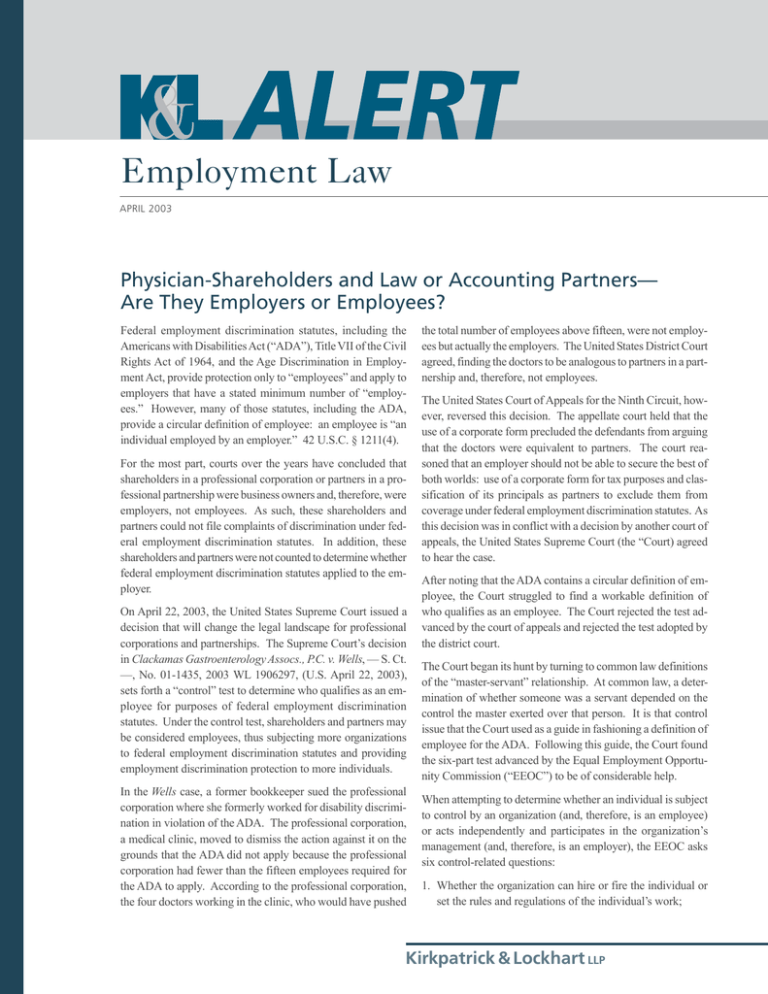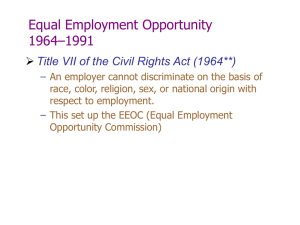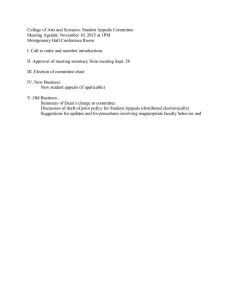Employment Law Physician-Shareholders and Law or Accounting Partners—
advertisement

Employment Law APRIL 2003 Physician-Shareholders and Law or Accounting Partners— Are They Employers or Employees? Federal employment discrimination statutes, including the Americans with Disabilities Act (“ADA”), Title VII of the Civil Rights Act of 1964, and the Age Discrimination in Employment Act, provide protection only to “employees” and apply to employers that have a stated minimum number of “employees.” However, many of those statutes, including the ADA, provide a circular definition of employee: an employee is “an individual employed by an employer.” 42 U.S.C. § 1211(4). For the most part, courts over the years have concluded that shareholders in a professional corporation or partners in a professional partnership were business owners and, therefore, were employers, not employees. As such, these shareholders and partners could not file complaints of discrimination under federal employment discrimination statutes. In addition, these shareholders and partners were not counted to determine whether federal employment discrimination statutes applied to the employer. On April 22, 2003, the United States Supreme Court issued a decision that will change the legal landscape for professional corporations and partnerships. The Supreme Court’s decision in Clackamas Gastroenterology Assocs., P.C. v. Wells, — S. Ct. —, No. 01-1435, 2003 WL 1906297, (U.S. April 22, 2003), sets forth a “control” test to determine who qualifies as an employee for purposes of federal employment discrimination statutes. Under the control test, shareholders and partners may be considered employees, thus subjecting more organizations to federal employment discrimination statutes and providing employment discrimination protection to more individuals. In the Wells case, a former bookkeeper sued the professional corporation where she formerly worked for disability discrimination in violation of the ADA. The professional corporation, a medical clinic, moved to dismiss the action against it on the grounds that the ADA did not apply because the professional corporation had fewer than the fifteen employees required for the ADA to apply. According to the professional corporation, the four doctors working in the clinic, who would have pushed the total number of employees above fifteen, were not employees but actually the employers. The United States District Court agreed, finding the doctors to be analogous to partners in a partnership and, therefore, not employees. The United States Court of Appeals for the Ninth Circuit, however, reversed this decision. The appellate court held that the use of a corporate form precluded the defendants from arguing that the doctors were equivalent to partners. The court reasoned that an employer should not be able to secure the best of both worlds: use of a corporate form for tax purposes and classification of its principals as partners to exclude them from coverage under federal employment discrimination statutes. As this decision was in conflict with a decision by another court of appeals, the United States Supreme Court (the “Court) agreed to hear the case. After noting that the ADA contains a circular definition of employee, the Court struggled to find a workable definition of who qualifies as an employee. The Court rejected the test advanced by the court of appeals and rejected the test adopted by the district court. The Court began its hunt by turning to common law definitions of the “master-servant” relationship. At common law, a determination of whether someone was a servant depended on the control the master exerted over that person. It is that control issue that the Court used as a guide in fashioning a definition of employee for the ADA. Following this guide, the Court found the six-part test advanced by the Equal Employment Opportunity Commission (“EEOC”) to be of considerable help. When attempting to determine whether an individual is subject to control by an organization (and, therefore, is an employee) or acts independently and participates in the organization’s management (and, therefore, is an employer), the EEOC asks six control-related questions: 1. Whether the organization can hire or fire the individual or set the rules and regulations of the individual’s work; Kirkpatrick & Lockhart LLP 2. Whether and, if so, to what extent the organization supervises the individual’s work; 3. Whether the individual reports to someone higher in the organization; 4. Whether and, if so, to what extent the individual is able to influence the organization; 5. Whether the parties intended that the individual be an employee, as expressed in written agreements or contracts; and 6. Whether the individual shares in the profits, losses, and liabilities of the organization. Under this new test, the use of a particular title, such as shareholder or partner, does not determine whether a person is, or is not, an employee. Instead, this control test is designed to consider all of the incidents of the relationship before determining whether an individual is an employee. The EEOC’s six-question test is useful in making this determination, but other factors may be considered as well. There is no single factor that controls the determination; rather, the answers to the various control questions will be weighed one against the other to see where the weight of the evidence lies. or committing torts. Further, while all the partners shared in the profits of the firm, the appeals court noted traditional, corporate employees similarly share in the profits by use of stock options and by the fact that profits drive the employee compensation process. Because of these facts, the appeals court found that it could not automatically exclude the former partners from the definition of an employee just because they were labeled as partners. The test approved by the Supreme Court has two immediate, critical impacts. First, small professional corporations and partnerships whose shareholders or partners, if counted as employees, would push employment numbers above the minimum number may find themselves subject to federal employment discrimination statutes. Second, professional corporations and partnerships must consider the possibility that any actions taken adverse to its shareholders or partners may be challenged under federal employment discrimination laws. While the Wells decision dealt with a professional corporation for ADA purposes, the decision will impact other employer organizations as well. A recent decision by the Seventh Circuit regarding whether partners in a law firm were employers (and, therefore, exempted from statutory coverage) or employees is one such example. In Equal Employment Opportunity Commission v. Sidley Austin Brown & Wood, 315 F.3d 696 (7th Cir. 2002), the United States Court of Appeals for the Seventh Circuit was faced with an investigation by the EEOC into employment actions taken by a law firm against former partners which the EEOC claimed violated the Age Discrimination in Employment Act (“ADEA”). The appeals court struggled with an argument advanced by the law firm that the ADEA did not apply to the decisions taken against the partners because they were employers, not employees. Without doing so explicitly, the appeals court effectively used a control test now adopted by the Supreme Court. STEPHEN M. OLSON solson@kl.com 412.355.6496 JEREMY A. MERCER jmercer@kl.com 412.355.8249 FOR MORE INFORMATION, please contact one of the following K&L lawyers: Boston Henry T. Goldman 617.951.9156 hgoldman@kl.com Dallas Jaime Ramón 214.939.4902 jramon@kl.com Harrisburg Carleton O. Strouss 717.231.4503 cstrouss@kl.com Los Angeles Thomas H. Petrides 310.552.5077 Paul W. Sweeney, Jr. 310.552.5055 tpetrides@kl.com psweeney@kl.com Miami Daniel A. Casey 305.539.3324 dcasey@kl.com Newark Marilyn Sneirson 973.848.4028 msneirson@kl.com New York David R. Marshall Rory J. McEvoy 212.536.4066 212.536.4804 dmarshall@kl.com rmcevoy@kl.com Pittsburgh Stephen M. Olson Michael A. Pavlick Hayes C. Stover 412.355.6496 412.355.6275 412.355.6476 solson@kl.com mpavlick@kl.com hstover@kl.com San Francisco Jonathan M. Cohen 415.249.1029 jcohen@kl.com Washington Lawrence C. Lanpher 202.778.9011 The appeals court noted the law firm had over 500 partners, but all the power resided in a 36-member, un-elected committee that, in turn, elected the firm’s executive committee; hence, the ability of any one partner to influence the partnership was severely limited. While the 500 partners could “bind” the firm by their actions, such as issuing opinion letters and the like, the appeals court noted traditional employees can also bind their employer by the employees’ actions, such as signing contracts llanpher@kl.com ® Kirkpatrick & Lockhart LLP Challenge us. ® www.kl.com BOSTON ■ DALLAS ■ HARRISBURG ■ LOS ANGELES ■ MIAMI ■ NEWARK ■ NEW YORK ■ PITTSBURGH ■ SAN FRANCISCO ■ WASHINGTON ............................................................................................................................................................... This publication/newsletter is for informational purposes and does not contain or convey legal advice. Please note that information about prevailing law is limited to the particular state or federal jurisdiction(s) covered by the cited law and cases, and stricter rules may apply in some states. This newsletter should not be relied upon in regard to any particular facts or circumstances without first consulting a lawyer. © 2003 KIRKPATRICK & LOCKHART LLP. ALL RIGHTS RESERVED.




